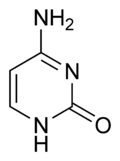Cytosine facts for kids
| Cytosine | |
|---|---|
 |
|
| IUPAC name | 4-amino-3H-pyrimidin-2-one |
| Identifiers | |
| CAS number | |
| PubChem | |
| MeSH | |
| SMILES | C1=C(NC(=O)N=C1)N |
| Properties | |
| Molecular formula | |
| Molar mass | 0 g mol-1 |
| Melting point | |
| Except where noted otherwise, data are given for materials in their standard state (at 25 °C, 100 kPa) Infobox disclaimer and references |
|
Cytosine is one of the 5 main nucleobases used in storing and transporting genetic information within a cell in the nucleic acids DNA and RNA.
In DNA and RNA, cytosine is paired with guanine. However, it is unstable, and can change into uracil (spontaneous deamination). This can lead to a point mutation if not repaired by the DNA repair enzymes such as uracil glycosylase, which cleaves a uracil in DNA.
See also
 In Spanish: Citosina para niños
In Spanish: Citosina para niños

All content from Kiddle encyclopedia articles (including the article images and facts) can be freely used under Attribution-ShareAlike license, unless stated otherwise. Cite this article:
Cytosine Facts for Kids. Kiddle Encyclopedia.